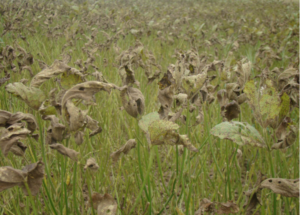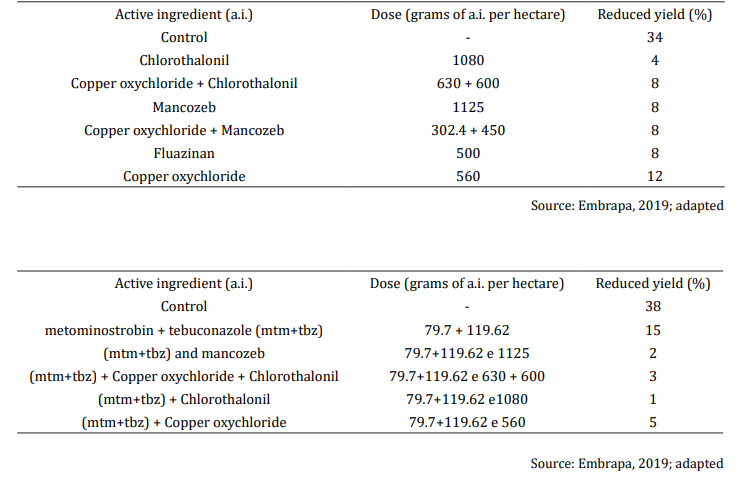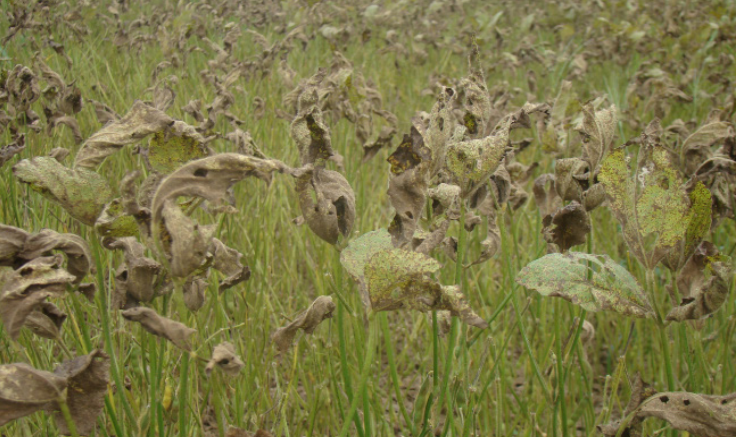
Asian rust, caused by the biological agent Phakopsora pachyrhizi, has disturbed Brazilian fields for years. However, at the 2019/2020 harvest, the phenomenon has a lower incidence today due to intense work and investment in the country, as explained by Dr. Cláudia Vieira Godoy, agronomist and doctor in phytopathology and researcher at Embrapa Soja, in the city of Londrina, Paraná state, for soybean research, where she works studying epidemiology and control of soybean diseases.
According to Embrapa, the average loss from 2001 to 2018 is equivalent to US$ 2.8 billion per season. According to the Conab (a state owned company controlled by the Ministry of Agriculture, in charge of government policy to ensure the production and supply of agricultural products) the 2018/2019 harvest recorded a yield of 115 million tons of soybean. In addition, according to CESB (Brazilian Strategic Committee of Soybean), a record of 123.88 bags per hectare was recorded, reestablishing Brazil among the largest world producers of the grain.
Dr. Cláudia Vieira Godoy granted this interview to AgriBrasilis, explaining about the disease that affects the soybean production and how this issue is managed in Brazil.
AgriBrasilis – What is the history of Asian rust in Brazil? How is the fungal incidence fluctuating in national production?
Dr. Cláudia Godoy – The disease caused by the fungus Phakopsora pachyrhizi was first identified
in Brazil in 2001, and quickly spread through the producing regions. Its presence is constant in the fields, but losses have been reduced over the years due to the proper management and strategy adoptions.
The rust incidence in recent years has been low in the first harvest of the year, much of it is due to the escape (escape is the period of total absence of live soy plants and the removal and prohibition of cultivation in the period between July 1st and September 15th to prevent the fungus of Asian rust to multiply during the end of the intake).
At large part of the growing areas there is no presence of the disease or it only happens at the end of the soybean cycle due to the use of early cultivars, sown at the beginning of the season to make a second harvest in summer.
AgriBrasilis – At national level, how serious is the disease?
Dr. Cláudia Godoy – The severity is lower than when the disease was introduced in Brazil. Many farmers still have the pathological agent in the farms and its control is the main objective of the use of fungicides, but it has been disappearing from the fields. In regions that do the sowing after November, the disease may require intensive control.

Losses in soybean productivity due to Asian rust. Courtesy of EMBRAPA.
AgriBrasilis – What are the main control strategies adopted by the Brazilian producers against P. pachyrhizi? How is the fungicide market today?
Dr. Cláudia Godoy – In 2006, the adoption of the sanitary break began, a period of at least 60 days during the off-season, in which the sowing of soybeans is prohibited and the elimination of volunteer
plants/weeds is mandatory to reduce the inoculum of the fungus. One thing that reduced its incidence was the use of earlycycle cultivars. Its adoption enabled two harvests in the summer, such as soybean-corn, soybean-cotton and soybeanbeans, and as a consequence there is the rust escaping.
The use of resistance genes (Rpp) do not dismiss the use of fungicides, but soybean cultivars with resistance genes have been made available. One of the major problems is the resistance (less sensitivity)
of the pathogenic fungus to fungicides from the group of demethylation inhibitors (IDM), external Quinone
inhibitors (IQe) and succinate dehydrogenase inhibitors (ISDH), these are the three main site groups that make up all registered fungicides in use for the disease control.
Multisite fungicides, such as mancozeb, chlorothalonil and cuprics, began to be used in soybean cultivation in 2013/14 to increase the efficiency of site-specific fungicides and also as an anti-resistance strategy.
AgriBrasilis – What is the fungicide testing consortium for disease control in soybean crops? What are the impacts of collecting such database?
Dr. Cláudia Godoy – The testing consortium are experiments with the same protocol in which registered
as well as products in the process of being registered are being evaluated for different biological targets in certain producing regions.
The experiments have been carried out since 2003 for asian rust and the great merit of the consortium is to
provide researchers in the multiple regions, going along the changes in the sensitivity of the fungus.
AgriBrasilis – What would be your perspectives for the Brazilian production in the future, taking into account the genetic resistance under the fungus that is often greater than the speed with which new products are launched?
Dr. Cláudia Godoy – The control with fungicides in Brazil is quite complicated due to resistance, but the
disease has had its incidence reduced in most regions. Despite it all, there are active ingredients still showing acceptable efficiency and the association with multi sites has helped. However, the fact that some of these products are being suspended in Europe may concern more than the resistance itself about the future of disease control.
In the successful results of the anti-rust fungicide consortium, as commented by the researcher, different active ingredients were evaluated by Embrapa, relating them with their applied doses and with the yield reduction in relation to a control without the inoculum of the disease.

Active ingredients tested together related to lost productivity. Source: Embrapa, 2019; Adapted.

